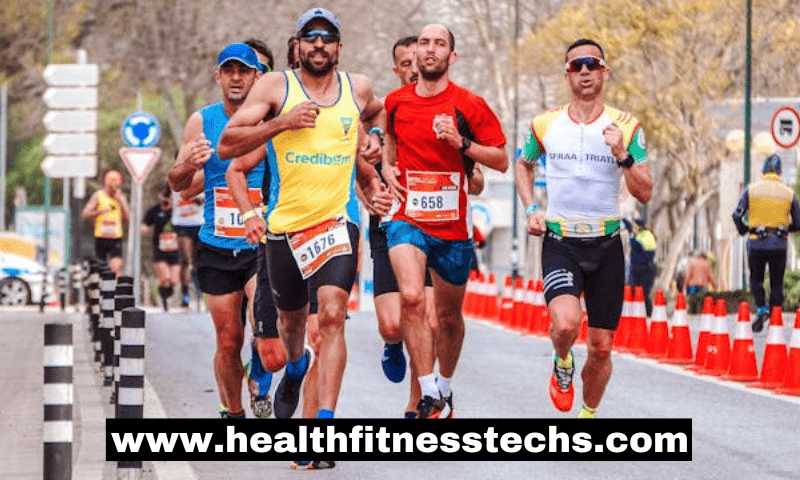The sport of running is much more than running with one foot in front to next. proper technique will rise efficiency speed and endurance as well as reduce chance of injuries. This article outlines fundamental running tips.. that will change your experience of running.
The Fundamentals of Proper Running Form
Running is an extremely popular exercise choice.. that is accessible and easy to do with numerous advantages for both mental and physical well being. But running in poor technique is likely to boost chance of injury and lower overall efficiency. If you are aware of and practice proper running posture youll be able to increase your efficiency lower your risk of injury and have more enjoyable and enjoyable run.
Head Position and Posture
- Make sure your head is at an appropriate level & keep your eyes 10 20 metres ahead. This helps maintain an ideal running position and helps prevent neck strain.
- Beware of looking towards your feet or turning your head to side. This can lead to neck pain as well as forward lean which could cause hip and back pain.
- Keep your jaw in relaxed position.. that lets you breathe easily. Keep your jaw at comfortable level and refrain from clenching your teeth.
- Relieve your jaw muscles and jaw muscles. Tension in your face may contribute to general muscular tension and fatigue.
Upper Body Mechanics
- Shoulder Position:
- Maintain your shoulders in relaxed position and lower. Be careful not to hunch or tighten your shoulders. This could cause upper back pain as well as bad posture.
- Relax your arms and allow natural movement with each swing. Your shoulders must move naturally when you swing your arms.
- Arm Movement:
- Make elbows bend at around 90 degrees. This makes for an efficient arm swing.
- Move your arms back and forward in straight line not crossing your body. Do not cross your arms in front of your chest because this could limit motion and result in shoulder pain.
- Relax your hands but without clenching them. Fists.. that are tight can create strain in your arm as well as shoulders.
- Arm swings should be matched to leg cadence. arms should be moving in natural rhythmic rate.. that corresponds to your leg rotation.
Core Engagement
- Be sure to maintain solid torso.. that is upright. Avoid leaning too in either direction in order to stress your hips and back.
- Get your core muscles engaged and relax them without stressing. Your core muscles are essential to keeping your running form in good shape as well as preventing injuries.
- Create natural rotation motion. Your core muscles will permit for an occasional rotation while you sprint.
- Do not lean too far either way. This can lead to back pain as well as inefficiency.
Lower Body Mechanics
- Hip Position:
- Make sure your hips are level and secure. Beware of excessive side to side motion.. that can cause painful hips as well as inefficiency.
- The hips should propel you forward. hips will generate forward thrust for your stride.
- Leg Action:
- Concentration on mid foot strike. This is when you land on your mid foot or in slightly backwards direction instead of using your heels or toes.
- You should place your feet below your bodys center of gravity. This will reduce strain on joints.
- Release with complete feet extension. Stretch your leg to create power and propel you forward.
- Maintain consistent stride length. Do not overstride or go too few strides.
Keep in mind.. that proper running form is process of gradual improvement.. that requires time to master. You must be conscientious and patient with your effort to boost your running form. Take advice from coach for running or physical therapist in case you are concerned or suffering from pain. When you are able to practice proper form of running and technique you will reduce chance of injury increase your running efficiency and have an enjoyable running experience.
Read Also :Types of Cardio Training: Comprehensive Guide
Breathing Techniques for Runners
Breathing is one of most important aspects of running. It is usually overlooked until situation arises. Learning correct breathing technique will increase endurance of your body decrease fatigue you experience & rise overall performance of your running.
Basic Breathing Patterns
- Rhythmic breathing synchronization Try to aim for an even rhythm between your breathing patterns and your strides. An effective pattern is to breathe in for two strides before exhaling for 2 strides.
- Nose in contrast to. breath through mouth: Although some athletes prefer to breathe with their nose however some prefer to breathe using their mouths in midst of intense workouts. Try out different methods to determine what is desirable for individual.
- Diaphragmatic breathing: Concentration on expanding diaphragm rather than your chest to increase capacity for your lung and oxygen you take in. technique can be practiced by placing your hand on your stomach & making sure.. that it expands when you breathe.
Advanced Breathing Methods
- 2:2 breathing method for easy runs. Breathe in for two strides. Exhale for same amount of strides. This breathing pattern is appropriate for run ins.. that are easy and rehabilitation sessions.
- 3:2 breath for speed of race: Inhale for three strides. Exhale for 2 strides. This breathing pattern is helpful in maintaining speed of your run or in intervals.
- Adjustments to breathing at higher altitudes When you are at higher elevations air becomes less dense making it difficult to breathe. Gradually improve your intensity in training in order to adjust to lower oxygen levels.
Running Cadence and Stride
Stride length and running cadence are crucial components for an efficient run. Knowing and optimizing these aspects will greatly increase efficiency of your run.
Understanding Cadence
- The optimal number of steps per minute: typical range for optimal cadence for running is 170 180 steps per minutes. But personal habits and preferences for running differ.
- How to determine your cadence Utilize running watch or an app for your smartphone to gauge your cadence. lot of running watches come with built in cadence sensors.
- Modifying cadence for various terrains: Change your cadence in accordance with environment. In other words rise your cadence slightly for hills in order to keep your speed.
Stride Length
- Find your natural stride Your strides natural length will be dictated by your bodys movements and your way you run. Test different stride lengths to determine what makes you feel most comfortable and effective.
- Stride errors.. that are common: Overstriding taking too long strides can result in increased strain on joints and legs. Concentration on keeping fast speed by taking shorter strides.
- Modifying your stride for hills In case of hills you should shorten your stride to keep equilibrium and ease stress on your legs.
If you can master breathing techniques & enhancing your pace and stride will boost your efficiency and have most enjoyable experience running. Be aware of your bodys signals try various methods & gradually rise level of intensity you exercise.
Specialized Running Techniques
Uphill Running
It is difficult but gratifying aspect of running. There are specific strategies to maximize efficiency and decrease stress.
Body Position Adjustments:
- Move slightly to left: This allows balance to be maintained and avoids excessive from overextending.
- Make sure your chest is wide open: This allows for maximum breathing & also prevents you from slouching.
- Engage your core Strong cores provide strength and stability.
Shortened Stride Technique:
- Make shorter steps: This reduces stress on your legs & can help to maintain your rate.
- mindfulness on cadence Make sure to maintain fast cadence in order to prevent excessively striding.
Power Generation and Efficiency:
- Get on your feet It generates force and pushes you upwards.
- Arm swings: Use your arms to create momentum and keep balance.
Recovery Strategies:
- Make most of sections downhill: Use downhill sections to rest and take deep breath.
- Hydration is essential: Stay hydrated before or during and even after you race.
Downhill Running
Running downhill needs completely different strategy to avoid injury and to maintain control.
Controlled Descent:
- Move slightly forward This will help you remain in straight line and prevents you from falling backward.
- Maintain your knees bent. It absorbs stress and shields joints.
- Be prepared: Concentration on where youd like to go not only your feet.
Foot Placement:
- Hit with your midfoot or forefoot. This helps reduce stress on your ankles heels & knees.
- Beware of heel strikes: Heel striking can boost chance of sustaining injuries.
Brake Management:
- Beware of excessive braking. Braking could cause stress on your calves as well as your hamstrings.
- Let gravity work for you: Allow gravity to drag you downwards instead of fighting against it.
Safety Considerations:
- Be careful on downhill slopes.. that are steep: Slow down and be patient.
- Pay attention for hazards: Be aware of root like rocks.. that are loose & other potential hazards.
Trail Running Techniques
Trail running provides distinctive and challenging adventure. ability to adapt to various terrains demands special strategies.
Terrain Adaptation:
- Change your stride Cut your stride short in rocky or rough terrain.
- Be aware of shifts in elevation: Adjust your pace and breathe accordingly.
- Use HTML0 to overcome obstacles. Learn how to hop through over or get around obstructions.
Obstacle Navigation:
- Check ahead: Anticipate obstacles and make your plans in line with them.
- Utilize your hands for balance: Use your hands for stability and support.
- Be aware of slippery surfaces. Be cautious and slow down. especially cautious when walking on trails.. that are muddy or wet.
Balance Maintenance:
- Get your heart moving Strong cores provide stability and equilibrium.
- Utilize arms for stability: Swing your arms to keep you well balanced.
- Exercise balance: Incorporate balance exercises in your routine of training.
Safety Awareness:
- Pay attention to surroundings around you: Pay attention to your surroundings and potential hazards.
- Bring necessary gear: Include water snacks as well as first aid kit along with map or GPS device.
- You can run with friend or tell someone about plans you have: Tell someone what youre doing and time youll arrive back.
If you master these specific training techniques for running youll be able to increase your running performance decrease risk of injury and experience much more enjoyable running enjoyment.
Common Technical Errors and Corrections
An effective running style is vital for improving performance while reducing injuries. Here are some of most common technical mistakes and their corrections:
Upper Body Mistakes
Arm swings.. that are too long: Excessive arm swing could cause balance issues and cause energy waste. Maintain your arms in relaxed position and extend them to 90 degree angle. Move your arms upwards and outwards with your natural movement allowing your arms to propel your towards forward direction.
Shoulder tension tension in your shoulders can cause neck pain as well as fatigue. Be sure to relax your shoulders & refrain from habit of hunching. Make sure you keep your head straight and keep your eyes straight forward.
Torso problems with rotation: excessive rotation of torso could cause energy loss and boost chance of injuries. Keep your posture upright and let your hips turn slightly when you run.
Lower Body Errors
Overstriding Overstriding is when your feet are placed overly far from centre of gravity. This could rise strain on your joints and cause to injury. Concentration to place your foot just underneath your body.
Heel striking Heel striking occurs moment when your heel comes into contact with ground before your heel. It can improve force exerted on joints & can lead to injury. You should aim for forefoot or midfoot strike.
Vertical oscillation high level of vertical oscillation or bouncing could cause energy loss and rise likelihood of injury. Concentration on maintaining steady and effective stride.
Problems with knee lifts: Excessive knee lift may boost strain on your joints and cause to injury. Make sure your knees are relaxed and keep them from lifting to high.
Injury Prevention Through Technique
Impact Management:
- The proper foot strike forms: Aim for forefoot or midfoot strike in order in order to minimize stress on joints.
- Distributing your weight: Ensure your weight is distributed evenly across your feet.
- Surface adaption Modify your running method to adapt your running technique to different surfaces. For instance on soft surface you might need to lower your feet slightly higher on your heels.
Recovery Techniques:
- Active recovery Participate in activities.. that require low intensity such as swimming walking or cycling for aid in recovery.
- Protocols for cooling down: Gradually reduce your speed and intensity in order to let your body get cool.
- Stretching routines: Incorporate dynamic as well as static stretching prior to and after running to increase flexibility as well as reduce your risk of injuries.
Additional Tips for Improving Running Technique
- Find skillful advice: Consider working with an athletic coach or physical therapist who can assess your body and get personalized tips.
- emphasis upon form not speed It is important to prioritize good form and techniques over speed especially when youre beginning your journey.
- Pay attention to your bodys needs: Pay attention to any discomfort or discomfort & modify your approach or take rest as required.
- Cross training Integrate other kinds of training for example cycling or swimming to ease strain on your muscles.. that are result of running as well as joints.
- Gradually rise mileage Do not increase mileage too rapidly to avoid injury from overuse.
- Drink plenty of water: Drink plenty of fluids before during as well as after your runs.
- Choose right footwear for you: Choose running shoes which are comfortable and offer additional sufficient assistance.
Through addressing most common errors in technology by implementing strategies to prevent injuries By addressing common technical errors and implementing injury prevention strategies you will rise form of your run decrease likelihood of injury and increase your running overall.
Training to Improve Running Form
The form of your running is essential for perfect performance and prevention of injuries. Focusing on certain exercises strengthening as well as advanced methods it is possible to boost efficiency of your running and speed.
Form Drills
Form drills are vital for improving your running technique and identifying certain actions. These are some drills.. that can be effective to include in your training:
- Knees high: Lift your knees to highest level you can while driving your legs inwards. This exercise aids to boost flexibility and speed in legs.
- Butt kicks Your heels should be pushed towards your glutes. This will emphasize power of fast and quick cycle of your legs.
- Skipping Skipping with knees high & quickly change. This training improves coordination and speed of your feet.
- Strides You should run at moderate pace with strides.. that are long with primary focus on expanding your strides length as well as turning.
Strength Training
Training for strength is crucial for getting better running form as well as prevent injuries. mindfulness on strengthening exercises for core lower back as well as your upper part of your body.
- Core workouts: Planks Russian legs twists as well as bicycle crunches are great for building muscles in your core.
- Strength of lower body Squats and lunges deadlifts and calf raises are essential for strengthening legs and increasing efficiency of running.
- Upper body balance rows push ups as well as overhead presses can rise upper bodys strength as well as balance. Balance is essential for maintaining good running posture.
- Functional movement: Incorporate functional movements such as kettlebell swings farmers walks kettlebell swings lifting sandbags to rise overall coordination and strength.
Advanced Running Techniques
After youve learned fundamentals then youre able to incorporate newer running strategies to increase speed of your run and boost your performance.
Racing Techniques:
- Positioning of starting line: Find comfortable place on line to allow shooter to respond quickly gun.
- Control of your pace You can learn to keep your pace energetically through course while preserving your energy for finishing.
- Positioning for tactical reasons: Understand how to place yourself in strategic way during race in order to stay clear of obstructions and boost your speed.
- Strongly finishing: Develop powerful final kick.. that will warrant.. that you reach line at highest effort.
Speed Work:
- Sprinting form Make sure you are practicing correct sprint technique. This includes arm drive leg turn as well as strong push off.
- Acceleration method: Learn to accelerate rapidly from standing position or at slower speed.
- Recovery position: Learn proper positioning for recovery between strides in order to keep good form and decrease fatigue.
- power development: Incorporate exercises which build power like plyometrics or hill sprints to rise your speed when running.


